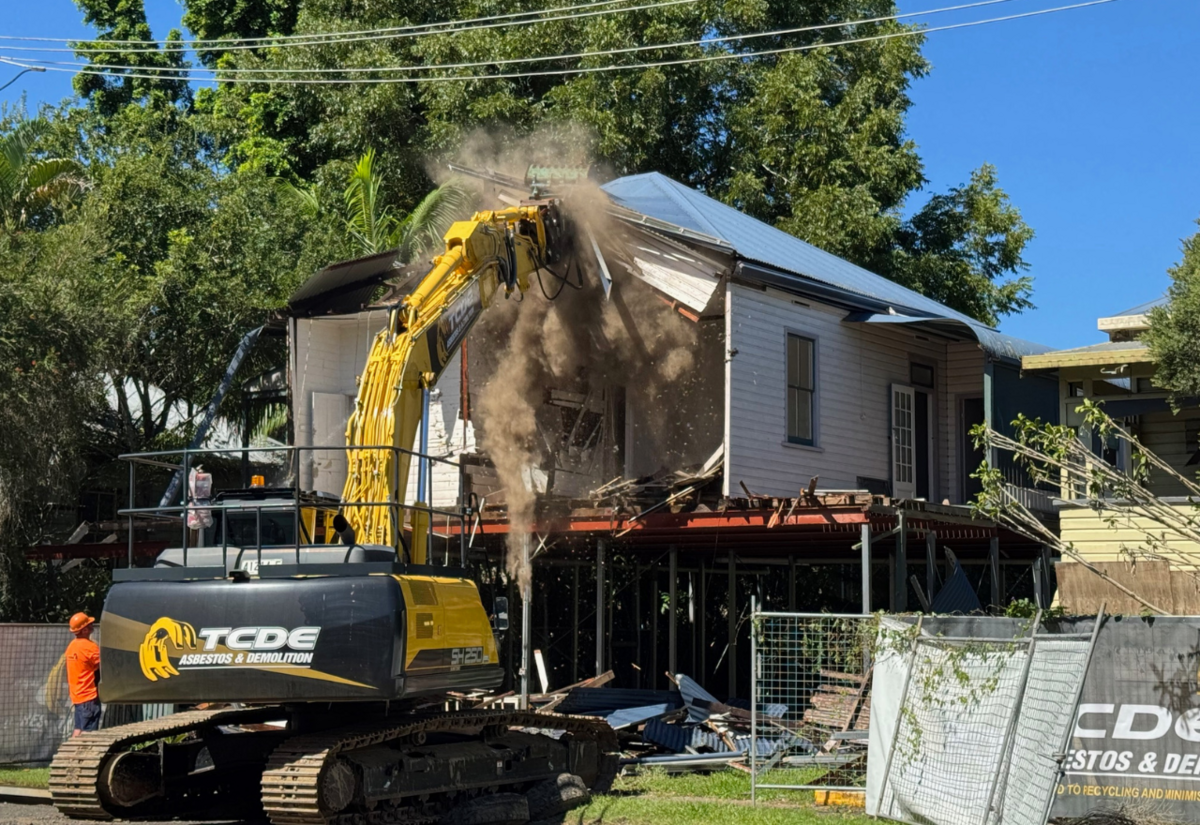Baillie Street demolition highlights unity to division in three years
Simon Mumford
07 April 2025, 8:00 PM
 A house on Baillie Street, North Lismore being demolished yesterday
A house on Baillie Street, North Lismore being demolished yesterdayThe NSW RA (Reconstruction Authority) began to demolish the next lot of buyback houses yesterday, this time on Baillie Street, North Lismore.
The activity will occur for the rest of the week as there are several homes to be demolished in an area that floods regularly as the Wilsons River wraps itself around the street, along with Wotherspoon Street on its way to the CBD.
The RA says that demolition only occurs after a "strict risk assessment".
Buyback house demolition has divided the community, as has the flood recovery itself.
Three short years ago, Lismore came together as a community to rescue those caught in the floodplain on 28 February 2022, some on their verandah standing in waist or chest-high fast-flowing water or those on their roof.
At that time of the flood, Lismore was more unified than at any other time in its long history.
Three years on, it feels like we are a more divided community than ever.
It began with the $800 million announcement by the state and federal government for the Resilient Homes Program ($700 million) and the $100 million Resilient Lands Program in October 2022.
This was after the Northern Rivers Reconstruction Corporation had tabled in parliament a costing of $1.5 billion for 2000 house buybacks, 2000 house raisings and 2000 home retrofits.
The $800 million has today become $880 million for the Resilient Homes Program (RHP) after the state and federal governments threw in another $90 million each last year.
It has long been known that the initial $1.5 billion was never going to be committed. The February 2025 estimate from NSWRA CEO Mal Lanyon is for a maximum of 1,300 house buybacks.
The reason given for the house buybacks was to remove the most vulnerable homeowners/renters from the floodplain and reuse the land for community purposes.
The initial debate was around affordably relocating the buyback houses that did not suffer irreparable damage, thus saving some historic Lismore big scrub hardwood homes.
This is where the community division begins.
Maybe in retrospect, the NSWRA should have started the Resilient Lands Program (RLP) before or at the same time it started the RHP. After all, you have a home to relocate but nowhere to move it to. Everything is clearer in hindsight. We need to keep in mind this type of program had never been rolled out before in NSW.
Affordability became a key issue. People bought or rented in the Lismore floodplain because it was cheaper. In conversations with real estate agents, it was their first step on the Lismore property ladder as a first home buyer. The other types of people on the floodplain were generational Southies and Northies.
These houses were $300,000 to $350,000 (approximately) in 2019. Then, during the COVID years, prices increased in a way Lismore hadn't seen before as people moved out of capital cities and into the regions. House prices were now around the $500,000 to $550,000 range.
The dilemma for those with a house buyback offer was that $500,000 would not buy them a house out of flood. That cost is more likely $700,000 plus. So, a $200,000 loan would be needed to move. Of course, getting a loan depends on your age and financial situation.
If you were to relocate a house, a block of land would be around $400,000, with removal costs of $120,000 to $150,000 plus renovation costs to make it liveable, including landscaping. Again, the price was north of $650,000 at best, depending on where you purchased the land.
In Lismore, for a flood-affected buyback person to move into similarly priced accommodation, they would be looking at a townhouse or unit. Simply put, the supply of these housing types is very low in the LGA, and no new construction has begun to date.
The affordability scenario combined with a housing crisis has exacerbated the situation.
To complicate matters, squatters then move into various NSWRA-owned buyback houses, especially Pine Street, claiming everyone has a right to have a roof over their head.
The flood recovery, which includes house relocation, raisings, retrofits and demolition, along with the development of identified land through the RLP, is moving far too slowly for some. One Lismore Facebook page admin put out a nationwide call "For all that are homeless to come to Lismore and I will give them addresses of the 100's of empty homes here."
This type of situation may slow progress further, or it may spur the NSWRA into acting faster, leading to more demolitions and fewer relocations as the RA tries to avoid more costly court action.
When asked about the latest demolitions and the reuse of materials, a spokesperson from the NSW Reconstruction Authority said, "Our aim is to recycle and reuse materials from homes during all demolitions. So far, contractors recycled more than 70 per cent of all materials. This includes timber, metal, concrete and organics.
"To date, 55.12 tonnes of metal, 883.46 tonnes of concrete and 62.48 tonnes of timber have been recycled. Over 1000 tonnes of materials have been recycled.
"Our priority is to relocate bought-back homes as much as possible however some have had to be demolished because they were structurally unsound, severely dilapidated, in high-risk areas or were unsafe to live in because of the presence of asbestos.
"We expect more demolitions will need to take place as part of the program however that decision is only made after a strict risk assessment.
"Eight homes were recently assessed as needing to be demolished because they were deemed high risk or impacted during ex-Tropical Cyclone Alfred.
"Neighbours in adjoining properties and previous owners of the homes have all been notified ahead of any work starting.
"Community members interested in enquiring about the recycled materials should contact the demolition contractors engaged by RA:
• TCDE: www.tcde.com.au/contact
• Mackay & Sons: www.houseremovals.com.au/contact-us/
"For ongoing updates, please visit the RA website at www.nsw.gov.au/departments-and-agencies/nsw-reconstruction-authority/our-work/northern-rivers."
There is a part of the community that disagrees with the NSWRA house demolitions. They are holding a community gathering on Baillie Street, North Lismore between 9:30am and 11:30am today. Reclaim Our Recovery says it is an open mic where you can have your say.
A statement from House You said that 50 homes have been demolished with a further 62 to go by mid-year, making a total of 112 Lismore flood-affected homes.
The NSWRA put 31 homes up for relocation, with multiple offers on some properties. The latest RHP figures for the NSWRA on March 28, 2025, showed that there have been 624 Buyback offers, with 540 approved. That leaves 397 more homes that will be relocated and/or demolished throughout the next few years.
The Lismore community understands the RHP and the RLP have had major issues; however, nothing can change the last three years of our flood recovery.
What has changed in the last three years is the shift from a united community willing to help each other in every way to a deeply divided community where verbal abuse is dealt out from both sides of the housing debate, and that is sad.

